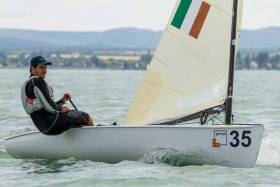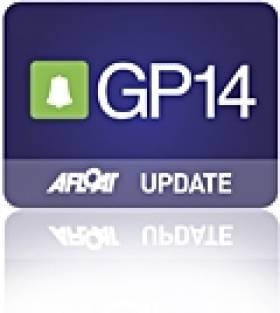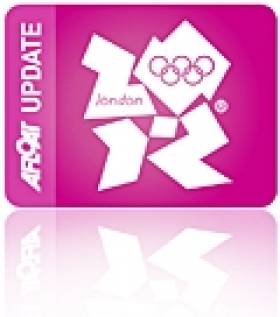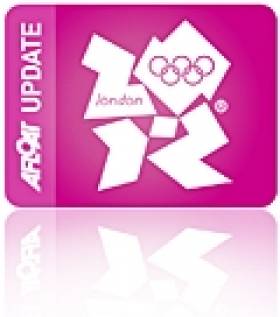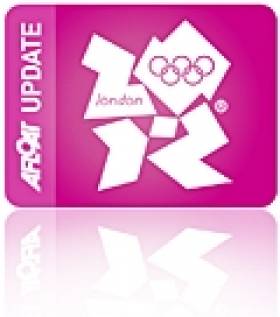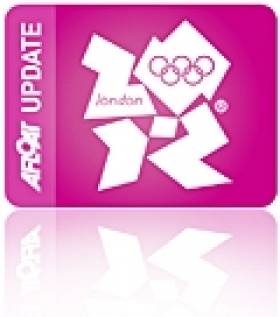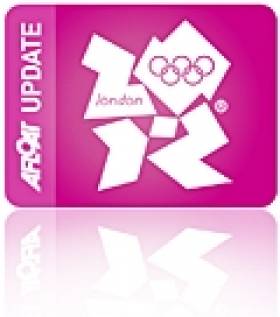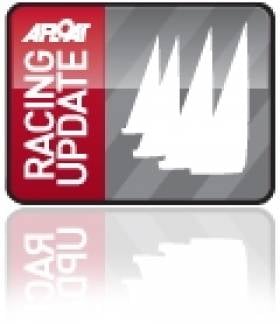Displaying items by tag: 470
French 'Team Racing' Protest Dismissed, Great Britain Wins Olympic Gold in 470 Women, Poland Silver, France Bronze
Hannah Mills and Eilidh McIntyre (GBR) have won gold in the 470 Women's class in the Tokyo 2020 Olympics, with Agnieszka Skrzypulec and Jolanta Ogar (POL) taking silver and Camille Lecointre and Aloise Retornaz (FRA) bronze.
At the start the fleet set off on starboard tack except for Skrzypulec and Ogar and the French team on port tack as both boats made an early break to the right.
Great Britain tacked over towards the other two boats and were ahead. Mills and McIntyre at times put a close cover on Lecointre and Retornaz to stop the French breaking through to the front of the fleet. Linda Fahrni and Maja Siegenthaler (SUI) and Luise Wanser Anastasiya Winkel (GER) were going fast and took the early lead.
Around the first mark Switzerland were ahead, with Great Britain in second and France back in sixth, one place ahead of Poland.
At the bottom of the course, Great Britain followed Switzerland to the right, the same for Poland while France simultaneously peeled away to the left with it still close for silver and bronze.
Halfway up the final leg, Poland moved up to fourth and were two places in front of France, equal on points. As it stood, the Polish team had displaced the French for silver.
Around the final turning mark, the Swiss held the lead while Great Britain were in second.
Fahrni and Siegenthaler won the Medal Race, taking fourth overall. Meanwhile, Great Britain had been overtaken on the final run by Germany, Israel and Poland. This put Poland back on equal points with France, giving them silver and France bronze.
However, immediately after the race, the jury was informed that the French team were protesting Great Britain.
The protest was heard ashore and the case was dismissed. It had been a brief delay to the medal celebrations, but at last Great Britain could celebrate the gold.
Along with silver from London 2012 and gold from Rio 2016, gold at Tokyo 2020 makes Hannah Mills the most successful ever female Olympic sailor. Eilidh McIntyre’s gold matches the achievement of her father Mike McIntyre who won Star keelboat gold for Great Britain in 1988. Lecointre repeats her bronze from Rio 2016.
Protest after 470 Women Medal Race delays final results
What was meant to be a straightforward gold medal celebration for Hannah Mills and Eilidh McIntyre (GBR) has had to be delayed until a protest has been heard and resolved onshore. France’s Camille Lecointre and Aloise Retornaz are protesting Great Britain for alleged team racing after a close tussle between the leading three contenders for the medals: Great Britain, France and Poland.
Linda Fahrni and Maja Siegenthaler (SUI) won the Medal Race, taking fourth overall. Meanwhile, Great Britain who had been second behind the Swiss, were overtaken on the final run by Germany, Israel and Poland. This put Poland back on equal points with France, giving silver and bronze to France.
However, immediately after the race the jury was informed that France was protesting Great Britain. The protest was heard ashore but dismissed by the jury.
81 470s from 25 countries (but not Ireland) will be competing from 30 April to 7 May in the men's, women's and the new mixed fleets for the respective European Champion titles in Vilamoura, Portugal.
34 out of the 40 Tokyo Olympic teams are racing in the men’s and women’s championships, along with a very strong mixed fleet in the first-ever Mixed 470 European Championship held by the Class.
International 470 Class President Andreas Kosmatopoulos commented: “Our European Championships are the last major event before the Olympic sailors head off to Enoshima, but we are far from over since Italy will host the Junior World and the Junior European Championships plus the Master's Cup in July and August. With the great support of Vilamoura Sailing in the last three months, we have managed to keep 470 competition alive against the odds by running the 470 World Championships, Warm-up and coaches' regattas and taking part in the Vilamoura Grand Prix series.
The competition is on a very high level and as we are in the final turn on the road to the Tokyo Olympic Games, the teams are eager to close their campaigns by winning the prestigious European titles”
Follow the championship here
Irish Sailing Delegation for World Sailing Conference
Ireland has always played a role in the affairs of World Sailing, formerly ISAF, formerly IYRU. The peak of Irish representation was in the years from 1998 to 2004, when Dubliner Ken Ryan served as Vice President.
Today, the representation isn’t at such a high level, but Irish Sailing is involved in key World Sailing Committees and maintains its place on the World Sailing Council. While Irish Sailing has nominated most of those listed below, Commissions are appointed by the Board and some have been appointed by the International Class they are affiliated with. Currently listed as IRL on World Sailing Commissions and committees are:
Council Marcus Spillane
Sailor Classification Commission David Meagher, Donal McClement, Jamie Wilkinson
Equipment Committee Cathy MacAleavy
Equipment Rules sub-Committee Curly Morris
Events Committee
Match Racing sub-Committee Michael O’Connor
Oceanic and Offshore Committee Paddy Boyd
Race Officials Committee Bill O’Hara
International Umpires sub-Committee Bill O’Hara
Race Management sub-Committee Con Murphy
Racing Rules Committee Bill O’Hara
World Sailing Classes Committee Curly Morris (Equipment Rules rep)
The World Sailing Annual Conference takes place later this week in Puerto Vallarta, Mexico.
Attending World Sailing's Mexico Conference from Ireland is Bill O'Hara, Marcus Spillane, Paddy Boyd, Con Murphy and Cathy MacAleavey.
Much of the focus at World Sailing Conferences is on the equipment that is chosen for Olympic Games. While the 2020 Games will use the classes that were used in Rio, the battle is on for selection for Paris 2024.
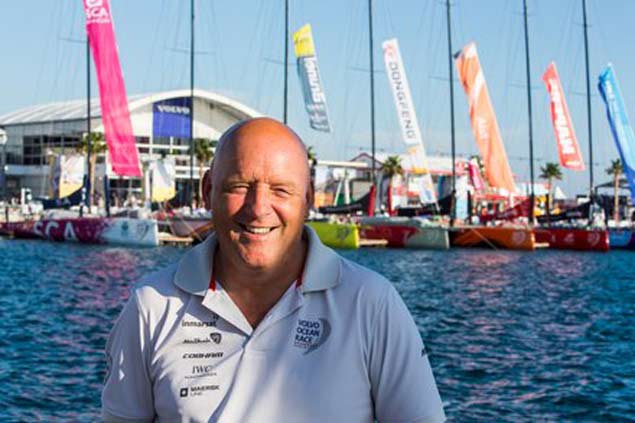 Bill O'Hara of Belfast Lough
Bill O'Hara of Belfast Lough
The final decision on this will not be taken until the 2018 Conference, but the debate is well under way, with the ”at risk” classes already lobbying to avoid the chop. World Sailing is seeking to align its Games strategy with the IOC’s Agenda 2020, so this November the discussion will be of a strategic nature considering the questions of gender equity (required by 2024), mixed classes, multi-medals (without increasing the quota) and evaluating new disciplines such as team racing, match racing and offshore events.
Four of the ten events will be reviewed in 2018, which four to be determined at the May 2018 meeting. The final decision on the events and the equipment used in those events will be made by the end of 2018, most likely at the 2018 November Conference. Currently, the men’s heavyweight event (Finn), is the only event not populated by both genders and as such will be under pressure.
The 470 is also coming under scrutiny as a dated class with one-design control issues, while the RS:X is also under threat as the equipment doesn’t enjoy popular appeal.
Removal of current events paves the way for consideration of an offshore two-handed mixed discipline, but the debate will also look at a more innovative approach, such as creating a team or match racing event amongst the athletes already selected, improving the medal count without increasing the total attendance.
Elsewhere on the agenda, amongst the usual governance issues, there are a couple of interesting proposals. One is to create a “Champion of Champions” event for World Champions in keelboat classes, similar in concept to Ireland's own 'All Irelands' competition.
In another initiative, the World Sailing Board is proposing to host an Offshore World Championships, two-handed, mixed gender in one-design boats. This is seen as a move to have IOC consider this discipline for future Olympic Games. it is most likely to be under review next year.
The World Sailing Annual Conference runs from November 4 to November 12, 2017.
Irish Olympic 470 Ace Lying Seventh at GP14 Worlds in Cornwall
#gp14 – It was only a short hop from Weymouth to Cornwall last week when the Olympic regatta finished for Irish 470 sailor Ger Owens who is currently placed seventh overall at the GP14 World championships underway at Looe Sailing Club in Devon today.
The Dun Laoghaire sailor with new crew Scott Flannigan rounded off his third Olympics in the 470 with with a 16th and a 5th on the final day to leave the pair 23rd overall.
Now the Royal St. George helm, who will miss out on tonight's OIympic homecoming at the National YC, has teamed up with Melanie Morris to lead Irish hopes at the 130-boat GP 14 event in which there is a strong Irish presence.
Moville Boat Club's John and Donal McGuiness are next Irish in ninth. Shane McCarthy and Andy Thompson from Greystones Sailing Club are in 13th place.
Racing continues today. Results here.
Laser Espey in 28th and Irish 470 25th at Weymouth
#laser #470 – Irish Laser sailor James Espey struggles to some good mid race positions in the largest of the Olympic fleets. Espey had a 28th in Race 7, at one point reaching 19th in the fleet. He also climbed during Race 8 fluctuating between 12th and 15th for the first half but ultimately crossed the line in 27th only two minutes behind the leader. Espey moves up seven places to 38th overall and will sail his final two races tomorrow, a medal race position is not a possibility.
The 470 duo, Ger Owens and Scott Flanigan had a further two races today. The pair had a 24th and 25th leaving them 25th overall after four races. They continue this today.
Sailing action starts at 12 noon in Weymouth.
Owens and Flanigan Chalk up a Win in Medemblik
#OLYMPICSAILING – London Olympic 470 pair Ger Owens and Scott Flanigan won the Delta Lloyd Regatta in Medemblik, Holland in the 470 class at the weekend.
Although it is widely recognised the fleet is not at full strength since the World Championships in Barcelona two weeks ago (where Owens and Flanigan qualified for London), the result is nevertheless a boost to the campaign winning four of their nine fleet races.
"This is unexpected. After qualification for the Olympics we weren't busy with winning here, so we're very happy. This is a big surprise for us'', Owens said.
Also competing at the regatta was Annalise Murphy who finished ninth overall and the Irish Paralympic Sailors John Twomey, Anthony Hegarty and Ian Costello in the Sonar class who finished 6th overall.
Scott Flanigan, from Malahide Yacht Club has recently qualified for the Olympics in the 470 class with Ger Owens. Ger is a double Olympian has represented Ireland in the 470 class in Athens and Beijing where he had two exciting race wins. Ger was Scott's coach for several years prior to the pair teaming up to campaign for London 2012 last summer, and Scott watched Ger racing in Beijing when he was fifteen. Scott who is now nineteen returned home this weekend for a couple of days rest, before resuming their Olympic campaign in Holland, and visited Malahide Yacht Club. He chatted to the Optimist sailors who were training with their coach David and was impressed with the new facility which opened earlier this year. He spoke encouragingly to the children and gave them some advice.
Colin O'Sullivan, one of the junior sailors interviewed Scott.
How did you get to be so good at sailing?
I started sailing an Optimist, then progressed to a Laser and then a 420, but I actually sailed anything that I got a chance to. I tried Catamarans, Mermaids, Yachts, anything that I could. You learn from every bit of sailing that you do, and learn from other sailors. Fitness and diet are also very important and I have been really lucky in having a great personal trainer, Colin Gaffney, from a young age.
Was it fun?
Yes it was, and I thoroughly enjoyed all the travelling I got to do in Ireland and all over the world. I have made great friends through sailing. I have been both a helm and a crew and have learnt a lot from both experiences.
How did you choose what boat to move into after your Optimist?
I won the Munster Championship in my last year, and that was my last Optimist event. I had already been sailing a Laser a bit, and I liked it. I was good in light winds and did pretty well. Then I moved to the 420 which was great, it was a new experience being part of a team, and I really enjoyed the technical side. Having sailed the 420 I think I would be so much better as an Optimist sailor!
What is your routine like?
When we are away training we sail most days. We start at 7am, head to the gym for a session and head out on the water for some training in the morning. We break for lunch for an hour, then back out again for the afternoon. We have spent most of the year in Palma as we are assured of good conditions and have training partners based there.
Do you have coaching every day?
Unfortunately due to financial constraints, we have not had a full time coach but Ross Killian attends most of the events with us as the support is essential when competing.
What other advice do you have?
My advice would be to keep a journal, it's really important. I have notebooks full of training information and things that I have noticed myself. Every sailor should keep a record of what they've learnt and what they've done. You also need goals, every time you go sailing, every event you compete in, try to have a goal. Sailing is not just about winning an event, it is also about improving. You might decide that you are going to improve your starts at a particular event, and that will be a focus while you're competing. Reading is important too, I have quite a library of sailing books I've picked them up all over the place.
What is your favourite place to sail?
It is hard to pick one venue but when I am at home I love to sail in Howth and Kinsale, and in Europe, Lake Garda and La Rochelle.
What were your best sailing moments?
Sailing in the Youth Worlds with Cian O'Regan in Istanbul, and representing Belvedere College with great success in the school sailing events, and of course qualifying for the Olympics.
What would you tell someone my age?
Sail everything you can. I have sailed Optimists, Fevas, 420s, 470s, Catamarans, and all classes of Yachts. I sailed the Topaz Westerns here in Malahide. Looks can be deceiving in boats but you will always learn something new by being adventurous.
Scott is heading off to Holland to continue his Olympic training programme with Ger Owens. We will be watching them and wish them luck.
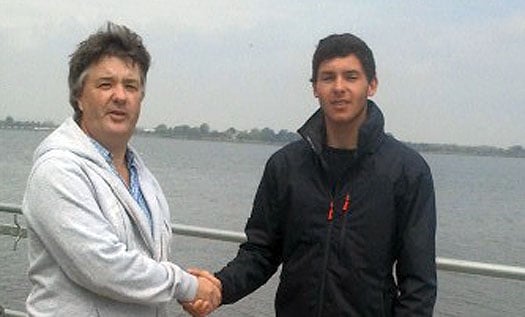
Scott (right) being congratulated on his achievement by MYC commodore Bob Sugrue
#470 – Ireland will be sending a five boat team (and that may yet rise to six) to the London Olympics following the qualification of Ger Owens for his third Olympic regatta in the 470 dinghy with new Howth crew Scott Flanigan.
As Afloat.ie previously reported this week the pair are currently sailing at the 470 World Championships in Barcelona where the final seven nation places are up for grabs in addition to the 20 that were allocated in 2011. The Dublin duo currently lie 24th overall on Day 3 following a 10th and a 13th in their two races today. The 95 boats have now split into gold, silver and bronze fleets. Owens and Flanigan are in the gold fleet and with the guarantee that they cannot fall lower than the 7th required nation thus securing their place in the Games.
#OLYMPIC 470 – Ger Owens and Scott Flanigan's good start to the 470 worlds in Barcelona at the weekend continued in to day two yesterday when the Dublin pair posted 11, 9 and 10 in the three races of the day.
The Royal St. George YC – Howth YC pair pulled themselves up from some poor first mark roundings making the best of the breezy conditions to overhaul rivals in the double-handed dinghy class.
Perfect sailing conditions ensured Barcelona lived up to its reputation as a great sailing venue. Racing got underway in 12 knots building to around 15-17 knots as the fleets completed race 4, with fairly wavy conditions.
The 94 boat championship fleet has two more races this morning before the fleet is split.
An additional seven Olympic places are up for grabs in Barcelona and the Irish pair are attempting to secure one of them. Today will prove to be a crucial day and will determine some of the next nations qualifying to the 2012 Olympic Games
Every race counts, but with three races yesetrday it was particularly crucial for teams to pump in some good scores and position themselves as solidly as possible before Tuesday's final two races of the qualification series at the 2012 470 World Championships.
It doesn't get better than three wins from three races, which is exactly what Lisa Westerhof/Lobke Berkhout (NED) delivered in the 470 Women blue fleet, matched by Mat Belcher/Malcolm Page (AUS) racing in the 470 Men yellow fleet.
Top ten, women, after 4 races
1. Lisa Westerhof/Lobke Berkhout, NED, 9 points
2. Gil Cohen/Vered Bouskila, ISR, 11
3. Ai Kondo/Wakako Tabata, JPN, 12
4. Jo Aleh/Polly Powrie, NZL, 12
5. Ingrid Petitjean/Nadege Douroux, FRA, 15
6. Camile Lecointre/Matilde Geron, FRA, 17
7. Kathrin Kadelbach/Friederike Burnet, GER, 19
8. Giulia Conti/Giovana Micol, ITA, 24
9. Sophie Weguelin/Sophie Ainsworth, GBR, 26
10. Fernanda Sesto/Consuelo Monsegur, ARG, 28
Top ten, men, after 4 races
1. Mathew Belcher/Malcolm Page, AUS, 4 points
2. Alvaro Marinho/Miguel Nunes, POR, 10
3. Sime Fantela/Igor Marenic, CRO, 11
4. Joonas Lindgren/Niklas Lindgren, FIN, 11
5. Panagiotis Mantis/Pavlos Kagialis, GRE, 14
6. Pierre Leboucher/Vicent Garos, FRA, 16
7. Onan Barreiros/Aaron Sarmiento, ESP, 18
8. Sam Kivell/Will Ryan, AUS, 20
9. Ryunosuke Harada/Yugo Yoshida, JPN, 21
10. Panagiotis Kampouridis/Esfstathios Papadopoulos, GRE, 23
All fleets have been re-seeded, so today the 149 teams competing at the 2012 470 World Championships will be up against a different set of opponents. Just two more races today to complete the qualification series and determine the split for the Gold and Silver fleets in the 470 Women and Gold, Silver and Bronze fleets in the 470 Men. The race throw out will come into play after five races, so expect some leaderboard shuffling.
Irish Sailing Round-Up: Wilson Trophy, 470, Star, SB20, 420, VOR, Rd Irl, ISORA & Comm Cup
#SAILING – Schull Youth Team from West Cork won the Under 21 Trophy at the Wilson Trophy in West Kirby in the UK yesterday and it represented a sweet revenge for the teenage three boat team.
Dublin's Ger Owens and Scott Flanigan final chance for Olympic selection at the 470 World Championships in Barcelona got off to a flying start yesterday with the double Olympian Owens finishing fifth in the opening race. It is an early boost for one of 7 remaining places left in the Summer Olympics. Ross Hamilton is also trying to qualify in the Finn class, he lies
It may have been 'gutting' not to come away with a medal at the Star world championships where Peter O'Leary and and David Burrows finished fourth overall but it was nevertheless a fantastic performance for the London qualified pairing who were third overall for most of last week.
Ben Duncan continues his domination of the SB3 class with a win in the 2012 Eastern Championships yesterday at the National Yacht Club who celebrated its yacht club of the year award last Wednesday.
There was success for Class III champion Supernova plus results from all 19 DBSC classes on Saturday in Dublin Bay.
Cork Harbour's Patrick Crosbie and Grattan Roberts were 420 dinghy winners at Galway Bay Sailing Club.
Offshore American Kenny Read and Team Puma is in back in the USA, a Volvo Ocean Race Win on the home waters of Miami all the more satisfying. The race will finish in Galway at the end of next month.
Billed as one of Europe's major yacht racing events, the 2012 Round Ireland Race starts on June 24th and an international fleet has been announced with UK entries at an all time high for Ireland's top offshore fixture.
Offshore sailing is on a high thanks largely to the pioneeing work of Peter Ryan with the Irish Sea fleet and why shouldn't we be our exploiting our offshore assets, sure don't we own 220 million acres? The third ISORA Race this weekend will feature virtual marks on the way to the Howth finish.
The title holder's absence may be Hong Kong's opportunity at the 2012 Commodore's Cup. Where is Team Ireland as Hong Kong builds up for the cup in just two month's time?
And in two week's time Howth Yacht Club report they have reached the magic number of 100 for the ICRA Cruiser Nationals at the North Dublin venue.


























